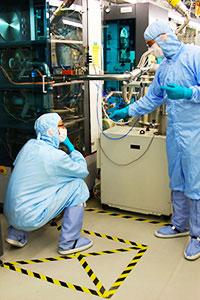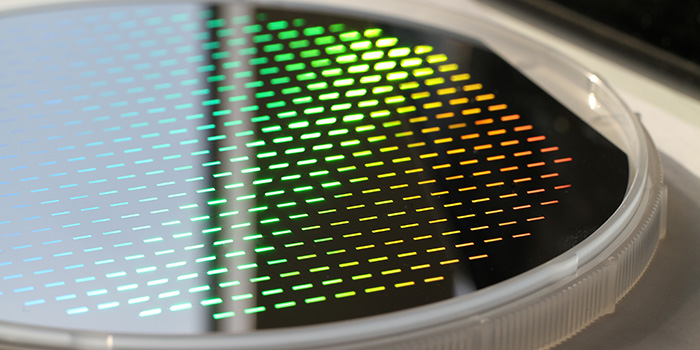09 MAR 17
By Iben Julie Schmidt
They are small, lightweight, and very precise, and contain no metal or electrical components. The new optical sensors may therefore play a key role in tomorrow's wind and oil industries, as they can be installed in locations where traditional sensors cannot be used.
We are so used to being surrounded by sensors that we no longer think about them.
Whenever we pick up our mobile phone or get into our car, a network of sensors work together to help us. For example, using sensors, we have been able to develop much safer vehicles with far better fuel economy.
Today, sensors are an indispensable part of most industrial processes. But there are places where traditional sensors have not yet made inroads, due to various difficulties. It is precisely this market that DTU spin-out, CEKO Sensors, is targeting with a new type of sensor.

CEKO's optical sensors are manufactured in the clean rooms at DTU Danchip. Photo: Iben Julie Scmidt
Measurement using light
The sensor is 100 per cent optical and measures using light that passes through a specially designed chip.
The chip contains no metal or electrical components and needs no wiring. Instead, the light is sent light through a thin glass fibre. This means that the signal can be transmitted over long distances without being impaired.
The first customer has already stepped up. Professor Rune Brincker heads the 'Structural Integrity and Reliability' research group at DTU's Centre for Oil and Gas. One of the group's research areas is how to extend the lifetime of offshore drilling rigs. Rune Brincker immediately saw the potential of the new sensors.
New knowledge about oil rigs
“We purchased the new sensors because we would like to know more about the structures we have standing in the North Sea. How are they affected by waves etc. and what stresses are they exposed to? There are currently very few measuring systems that are in place constantly. So we don't have enough data, but that may change now. These sensors represent a new technology which resolves some of the problems with more traditional measuring systems. We have very high safety requirements on offshore platforms. We therefore avoid electrical sensors, which could generate a spark and trigger an explosion. We avoid this problem if we use CEKO's sensors. They are also far more durable and reliable longer-term,” says Professor Brincker.
“If we peek the future, I think this is the technology that will be used, because it is designed with fewer components. I also expect the sensors will become more precise, while remaining low cost.”
Fulfilling these expectations is actually CEKO's strategy. The company's two founders—Kasper Reck-Nielsen and Christian Østergaard—both come from DTU Nanotech, where the technology behind the new sensors was developed and patented.
Sensitive chip
“We have combined existing technologies in our sensors, such as fibre optics and chip technology. We added a twist to these that allows us to achieve higher sensitivity, while keeping the cost down,” explains Christian Østergaard.
The sensor utilizes a principle based on a nanostructure called Bragg Grating. It involves allowing white light to pass tiny structures which reflect the light in various colours (wavelength intervals). Rather than measuring the intensity or quantity of light that comes through a fibre, you measure changes in the colour of the reflected light.
The big advantage of this is that you can place multiple sensors on a fibre and create a sensor network, because each sensor reflects a particular wavelength interval, while the rest of the light passes through. A change in vibration will thus be detectable as a change in the colour of the reflected light.
Light slowed down
“Fibre Bragg Grating technology has been around for many years. The new and interesting thing about our sensors is that we have found a method to compress light as it passes through the chip. So it is the speed of light which is changed, and not the distance between the tiny structures. This actually makes our sensor 1,000 times more sensitive than existing optical sensors. The result is a sensitive sensor which is also so robust that it can be installed in very exposed locations in harsh environments. This combination opens the door to new markets where sensors have not yet made inroads,” explains Kasper Reck-Nielsen.
Key data for wind industry
Yet it is not the oil and gas industry which the company has set its sights on as the primary market for the new sensors. It is the wind industry.
Imagine what valuable information you could reap if you put sensors on the blades of the large offshore turbines, which send real-time data back to shore while the turbine is generating electricity.
“Changes in the blades' vibration patterns can reveal small irregularities on the blades, and provide warning that it is time for a service visit before this has a serious impact on operation. The sensors could also be used to warn about ice formation, etc. In general, by continually monitoring operation, it will be possible to significantly optimize power generation,” explains Kasper Reck-Nielsen.
To date, people have not even considered putting sensors on the blades, because an electrical sensor would attract lightning, with a risk of damaging the blade or the entire turbine. These sensors—with no metal or electrical components—open up a whole new world.
CEKO is currently working with DTU Wind Energy and several of the world's largest wind turbine manufacturers to carry out long-term testing of the sensors on wind turbines.
According to Kasper Reck-Nielsen, the aim is that in five years' time, a handful of the sensors will be installed on one in three new wind turbines. This would mean production of around 1,000 sensors per month, solely for the wind turbine industry.
Pressure measurement in oil wells
There are other application areas that CEKO plans to investigate. Aeroplane wings is another obvious place the sensors could be used. But the technology also permits other types of sensors than vibration sensors (accelerometers) and hence a wide range of applications.
“We are currently testing a sensor that measures pressure in oil wells. In this case, the sensor has to measure far underground, at temperatures of several hundred degrees and under extreme pressure. It also has to handle being washed in hydrochloric acid,” explains Kasper Reck- Nielsen.
The test is looking promising, so Kasper Reck-Nielsen and Christian Østergaard see a bright future for CEKO, and Professor Rune Brincker agrees:
“If you need to make something really robust, you must make it very simple. CEKOs sensor has a simple design and is based on a technology with a huge potential. I expect it will be able to compete with the precision of traditional sensors within the not too distant future.”
How an optical sensor works

A fibre-optical sensor works by passing light from a laser through a fibre—and in the case of CEKO's sensors—through a specially designed chip. The properties of the chip change the light as a function of vibration, pressure, etc. The changed light signal is sent back to a spectrometer, which reads it and translates it into data that can be processed on a computer.
Rather than measuring the intensity or quantity of light that comes through a fibre, the colour of the reflected light is measured. The big advantage of this is that you can place multiple sensors on a fibre and create a sensor network, because each sensor reflects a particular wavelength interval, while the rest of the light passes through. A change in vibration will thus be detectable as a change in the colour of the reflected light.
The reflection of light in specific colours is created by passing the light through nanosize gratings with a particular periodic distance. Within the industry, this principle is used in Fibre Bragg Grating sensors. The idea is that if the light strikes a periodic structure it will resonate. This allows a specific wavelength to be reflected—one that precisely matches the period Λ.
If you stretch the fibre you extend the period, and a different wavelength and hence colour will be reflected. This can be described using the following formula:

But in CEKO's sensors, the light passes through a chip that compresses the light as it passes. This changes its speed. In other words, it is neff in the formula that is changed and not Λ—and this is what makes the sensor far more sensitive.
CEKO Sensors ApS
CEKO is a start-up company that manufactures optical sensors based on research and two patents from DTU Nanotech. The first sensors sold have been vibration sensors (accelerometers), but other types of sensors are under development. The company was founded by Kasper Reck-Nielsen and Christian Østergaard on 1 May 2015, with investment from Syddansk Teknologisk Innovation. CEKO is housed in the Scion DTU science and technology park in Lyngby, close to the fabrication facilities in DTU Danchip where the sensors are now in production.
Read more at www.cekosensors.com
CEKO's optical sensors are manufactured in the clean rooms at DTU Danchip.















